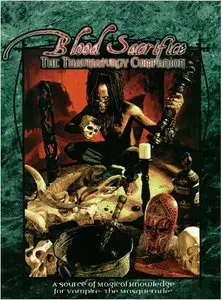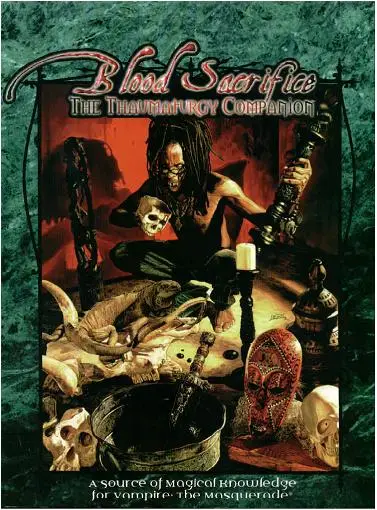Blood Sacrifice: The Thaumaturgy Companion (Vampire: The Masquerade)
White Wolf Publishing | 2002-01 | ISBN 1588462226 | PDF | Pages 96 | 10.31 MB
Unlike the previous Blood Magic book, this book explores non-western and non-Tremere blood magics. After all, Assamite sorcerers, undead Brahmins and Setite mystics have their own dark secrets far older than the upstart Tremere. If you intend on using non-western Thaumaturgy a lot, this book is almost required. The mechanics are explored for each form of Blood Magic, but the most important aspect is that the philosophy behind each form is explored in detail. Common beliefs, spiritual connections and mystic tools are given for every style.
The first section focuses on Akhu, the dead magics of Egypt which the Setites have become so well known for. While not exclusive to the Followers of Set, the small handful of other Egyptian vampires who practice Akhu still honor Set in their practices. This chapter goes into great detail on Egyptian mysticism and beliefs, explaining important Egyptian Gods and Goddesses (yes, including Set) and beliefs in the underworld. Most of the Paths used in Akhu are already existing Thaumaturgy Paths called by Egyptian names (Sutekh's Valor and Path of Anubis for example), but there are lots of specific rituals for Setite mystics as well. There are also a couple new paths, such as Ushabti (creating working servants) and Path of Duat (underworld magic).
Assamite fans will be pleased by the next chapter, covering Dur-An-Ki, the magics of the ancient Middle East. Drawing on everything from ancient Mesopotamian, Hittite, Persian and Assyrian rites to Jewish qabbala to Christian and Islamic mysticism to Neo-Platonic philosophy, this is a pretty potent collection of traditions (both living and dead). Although dominated by Assamite sorcerers, it also is known by some Middle Eastern Brujah, Hajj Nosferatu, Mithraic Ventrue and many other Mid-Eastern ashipu. Special notice is made that there is a schism between older practicioners, who lierally worship Mithras, Marduk, Dagon and so forth, and younger practicioners, many of whom are Jews, Christians or Muslims. Again, most of the paths and rituals are regular Thauamturgy with names made more "Arabic" or "Mid-Eastern". Alot of the names come from the revised Assamite clanbook. However, there are some new rituals, many based off Arab folklore and Mesopotamian mythology. There are also some new paths, like the Evil Eye (self-explanatory) and Covenant of Nergal (disease magics).
Sadhana, tantric blood magic of India, is explored next. This magic is steeped very heavily in Hindu belief, which isn't too unusual. However, the way that vampires interpert Hinduism is somewhat different from the way that living Hindus do. Nonetheless, this is still an excellent chapter. This magic, is should be noted, is the exclusive property of the Brahmin class and, as such, is unique almost entirely to the Setites, Ventrue and Ravnos, the ruling castes in India. Notes on Hindu beliefs (and vampiric perversions thereoff) along with Hindu Gods and various Indian symbols and beliefs are given. Again, most paths are already existing Thauamturgical paths, though there are plenty of new rituals (some of which are quite potent). New Paths, including the long awaited Path of Karma, and the Blood-Nectar Path (which, incidentally, the Assamites know a variation of) are given.
Finally, we also get a look at Wanga, blood magics that were spawned from Afro-Carribean traditions. As might be expected, Wanga is used primarily by the Serpents of Light, Samedi and other Kindred from that region. The section explores the beliefs of various Afro-Carribean faiths, with the majority being devoted to Voudon, Santeria and Palo Mayombe. As could be expected, Wanateurs need to believe in one (or more) of these religions to use Wanga. Important Loas, Orishas and Nikisi are explored, along with commmon tools in Voudon. Again, most common Thaumaturgy paths and rituals are used in Wanga, along with some unique rituals. New Paths, including Voice of the Wild (an animal based path), are given. This chapter does briefly mention that similar magics are used in Africa, but it doesn't go into details. Presumably, more on African blood magic will be explored in Kindred of the Ebony Kingdom.
The book closes out with a Storyteller section, which gives some more Rituals for both Koldunic Sorcery and Voudon Necromany, and some odds and ends. There is alot of information on "spontaneous talismans" and how to use them in your Chronicles. There is also a write-up for the Tlacique, an Aztec/Mayan/Incan bloodline of Setites, and their own blood magics. Drawing from Olmec, Toltec, Aztec, Mayan, Incan and other traditions, this is pretty dark and gruesome stuff. The Path of Xipe Totec is pretty nasty!
All in all, this is an excellent book. Players of Assamites will definately appreciate how fleshed out Dur-An-Ki has become, while anyone who wanted to use Setite blood magics will appreciate the fleshing out of Egyptian, Indian, Voudon/Santerian and Aztec/Mayan/Incan blood magics. Given the heavy focus on Egypt, the Middle East and Africa, this could also be appropriate for running "Year of the Scarab" games or Mummy-crossovers (or you could use the Tlacique and their magics if you want to crossover with the South American Capacocha). Regardless of how you use it though, this book can be very useful for both players and STs.



